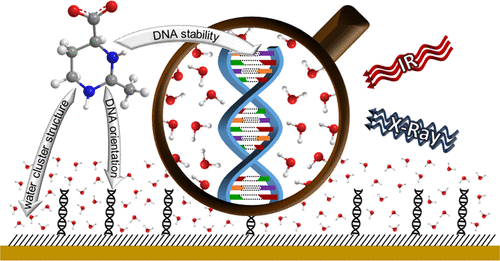当前位置:
X-MOL 学术
›
J. Phys. Chem. B
›
论文详情
Our official English website, www.x-mol.net, welcomes your
feedback! (Note: you will need to create a separate account there.)
What Does Ectoine Do to DNA? A Molecular-Scale Picture of Compatible Solute-Biopolymer Interactions.
The Journal of Physical Chemistry B ( IF 2.8 ) Pub Date : 2020-08-20 , DOI: 10.1021/acs.jpcb.0c05273 Julia Wittmar 1 , Susann Meyer 2 , Thorben Sieling 1 , Jörg Kunte 2 , Jens Smiatek 3 , Izabella Brand 1
The Journal of Physical Chemistry B ( IF 2.8 ) Pub Date : 2020-08-20 , DOI: 10.1021/acs.jpcb.0c05273 Julia Wittmar 1 , Susann Meyer 2 , Thorben Sieling 1 , Jörg Kunte 2 , Jens Smiatek 3 , Izabella Brand 1
Affiliation

|
Compatible solutes accumulate in the cytoplasm of halophilic microorganisms, enabling their survival in a high-salinity environment. Ectoine is such a compatible solute. It is a zwitterionic molecule that strongly interacts with surrounding water molecules and changes the dynamics of the local hydration shell. Ectoine interacts with biomolecules such as lipids, proteins, and DNA. The molecular interaction between ectoine and biomolecules, in particular the interaction between ectoine and DNA, is far from being understood. In this paper, we describe molecular aspects of the interaction between ectoine and double-stranded DNA (dsDNA). Two 20 base pairs-long dsDNA fragments were immobilized on a gold surface via a thiol-tether. The interaction between the dsDNA monolayers with diluted and concentrated ectoine solutions was examined by means of X-ray photoelectron and polarization modulation infrared reflection absorption spectroscopies (PM IRRAS). Experimental results indicate that the ability of ectoine to bind water reduces the strength of hydrogen bonds formed to the ribose-phosphate backbone in the dsDNA. In diluted (0.1 M) ectoine solution, DNA interacts predominantly with water molecules. The sugar–phosphate backbone is involved in the formation of strong hydrogen bonds to water, which, over time, leads to a reorientation of the planes of nucleic acid bases. This reorientation destabilizes the strength of hydrogen bonds between the bases and leads to a partial dehybridization of the dsDNA. In concentrated ectoine solution (2.5 M), almost all water molecules interact with ectoine. Under this condition, ectoine is able to interact directly with DNA. Density functional theory (DFT) calculations demonstrate that the direct interaction involves the nitrogen atoms in ectoine and phosphate groups in the DNA molecule. The results of the quantum-chemical calculations show that rearrangements in the ribose-phosphate backbone, caused by a direct interaction with ectoine, facilitates contacts between the O atom in the phosphate group and H atoms in a nucleic acid base. In the PM IRRA spectra, an increase in the number of IR absorption modes in the base pair frequency region proves that the hydrogen bonds between bases become weaker. Thus, a sequence of reorientations caused by interaction with ectoine leads to a breakdown of hydrogen bonds between bases in the double helix.
中文翻译:

Ectoine对DNA有什么作用?兼容的溶质-生物聚合物相互作用的分子规模图。
兼容的溶质在嗜盐微生物的细胞质中积累,从而使其能够在高盐度环境中生存。Ectoine是一种相容的溶质。它是一种两性离子分子,可与周围的水分子强烈相互作用,并改变局部水合壳的动力学。Ectoine与生物分子相互作用,例如脂质,蛋白质和DNA。外泌素和生物分子之间的分子相互作用,特别是外泌素和DNA之间的相互作用,还远远没有被理解。在本文中,我们描述了外壁蛋白和双链DNA(dsDNA)之间相互作用的分子方面。通过硫醇系链将两个20个碱基对长的dsDNA片段固定在金表面。借助X射线光电子和偏振调制红外反射吸收光谱仪(PM IRRAS),检查了dsDNA单层与稀释和浓缩的ectoine溶液之间的相互作用。实验结果表明,油桃素结合水的能力降低了dsDNA中形成于核糖-磷酸骨架的氢键的强度。在稀释的(0.1 M)菌素溶液中,DNA主要与水分子相互作用。糖-磷酸盐主链参与了与水形成牢固的氢键,随着时间的流逝,这导致核酸碱基平面的重新定向。这种重新定向使碱基之间的氢键强度不稳定,并导致dsDNA部分去杂化。在浓缩的果胶溶液(2.5 M)中,几乎所有的水分子都与ectoine相互作用。在这种条件下,油桃素能够直接与DNA相互作用。密度泛函理论(DFT)的计算表明,直接相互作用涉及DNA分子中的氢氧磷和磷酸氢根。量子化学计算的结果表明,核糖-磷酸骨架中的重排是由于与菌素的直接相互作用引起的,从而促进了磷酸基团中的O原子与核酸碱基中的H原子之间的接触。在PM IRRA光谱中,碱基对频率区域中IR吸收模式数量的增加证明碱基之间的氢键变弱。因此,由与ectoine相互作用引起的一系列重新定向导致双螺旋碱基之间的氢键断裂。
更新日期:2020-09-18
中文翻译:

Ectoine对DNA有什么作用?兼容的溶质-生物聚合物相互作用的分子规模图。
兼容的溶质在嗜盐微生物的细胞质中积累,从而使其能够在高盐度环境中生存。Ectoine是一种相容的溶质。它是一种两性离子分子,可与周围的水分子强烈相互作用,并改变局部水合壳的动力学。Ectoine与生物分子相互作用,例如脂质,蛋白质和DNA。外泌素和生物分子之间的分子相互作用,特别是外泌素和DNA之间的相互作用,还远远没有被理解。在本文中,我们描述了外壁蛋白和双链DNA(dsDNA)之间相互作用的分子方面。通过硫醇系链将两个20个碱基对长的dsDNA片段固定在金表面。借助X射线光电子和偏振调制红外反射吸收光谱仪(PM IRRAS),检查了dsDNA单层与稀释和浓缩的ectoine溶液之间的相互作用。实验结果表明,油桃素结合水的能力降低了dsDNA中形成于核糖-磷酸骨架的氢键的强度。在稀释的(0.1 M)菌素溶液中,DNA主要与水分子相互作用。糖-磷酸盐主链参与了与水形成牢固的氢键,随着时间的流逝,这导致核酸碱基平面的重新定向。这种重新定向使碱基之间的氢键强度不稳定,并导致dsDNA部分去杂化。在浓缩的果胶溶液(2.5 M)中,几乎所有的水分子都与ectoine相互作用。在这种条件下,油桃素能够直接与DNA相互作用。密度泛函理论(DFT)的计算表明,直接相互作用涉及DNA分子中的氢氧磷和磷酸氢根。量子化学计算的结果表明,核糖-磷酸骨架中的重排是由于与菌素的直接相互作用引起的,从而促进了磷酸基团中的O原子与核酸碱基中的H原子之间的接触。在PM IRRA光谱中,碱基对频率区域中IR吸收模式数量的增加证明碱基之间的氢键变弱。因此,由与ectoine相互作用引起的一系列重新定向导致双螺旋碱基之间的氢键断裂。











































 京公网安备 11010802027423号
京公网安备 11010802027423号